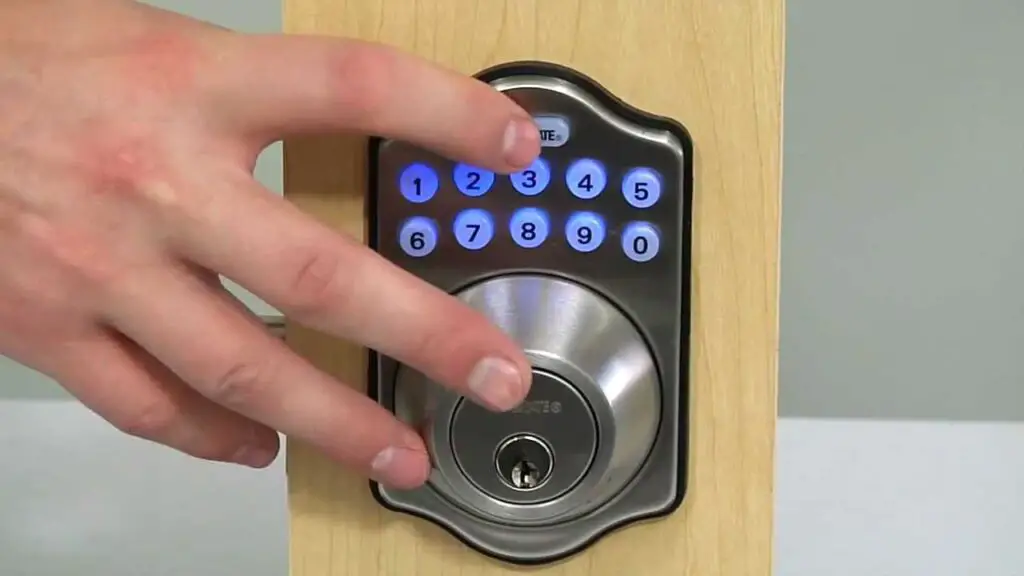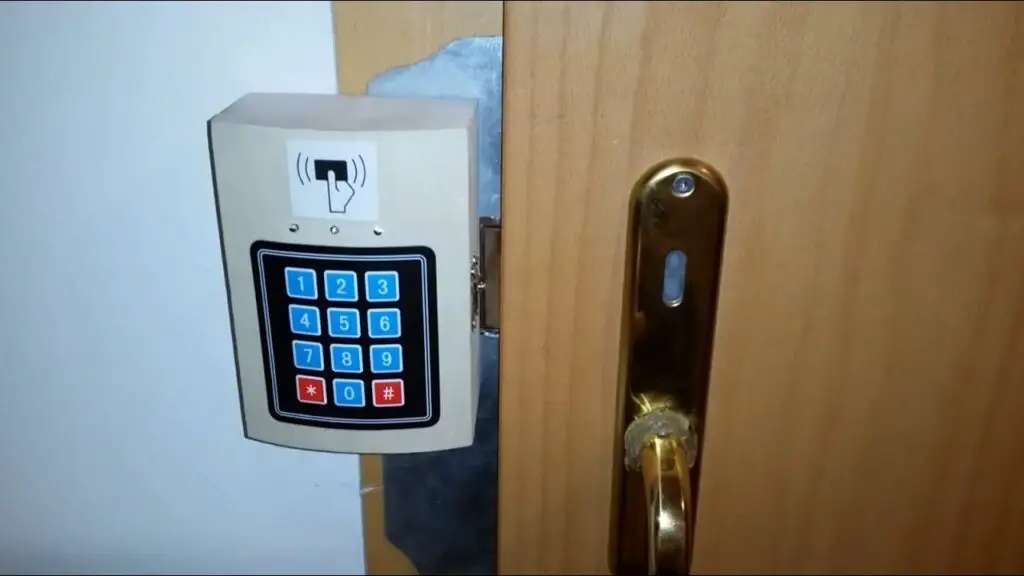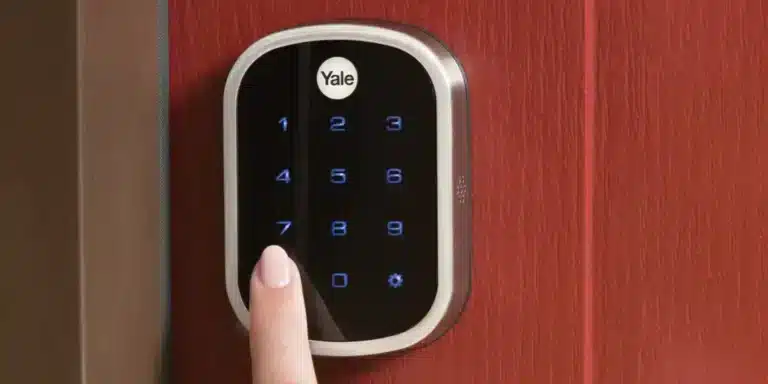Introduction
How To Use Keypad Door Lock: Keypad door locks have become increasingly popular in recent years due to their convenience and enhanced security features. Gone are the days of fumbling for keys or worrying about lost or stolen keys. With a keypad door lock, all you need is a unique code to gain access to your home or office. In this article, we will explore the various benefits and uses of keypad door locks, as well as provide a step-by-step guide on how to effectively use them.
One of the primary advantages of keypad locks is the enhanced security they offer. Traditional locks can be easily picked or tampered with, but keypad door locks provide a higher level of protection. With a unique code, you can ensure that only authorized individuals can enter your premises. Additionally, keypad door locks often come with built-in alarm systems that can alert you in case of any unauthorized attempts to access your property.
Using a keypad door lock is incredibly convenient, especially if you frequently find yourself misplacing or losing your keys. With a keypad lock, you no longer need to carry around a bulky keychain or worry about forgetting your keys inside your home. Instead, all you need to remember is your unique code, which can be easily programmed into the lock. This makes keypad door locks particularly useful for families with children or individuals who often have their hands full.
Advantage Of Keypad Door Locks
Another advantage of keypad door locks is the ability to create multiple access codes. This feature is particularly useful for businesses or rental properties where different individuals may require access at different times. With a keypad door lock, you can easily assign unique codes to each person, allowing you to track who enters and exits your premises. This eliminates the need for physical keys and provides a higher level of security and control.
Keypad door locks offer a convenient and secure alternative to traditional locks. Keypad door locks are popular with homeowners and businesses because to its increased security, convenience of use, and ability to generate numerous access codes. We’ll explain how to use a keypad door lock in the following parts so you can maximize this unique technology.

How do keypad door knobs work?
Keypad door knobs are a modern and convenient alternative to traditional lock and key systems. These innovative devices provide a secure and keyless entry into homes, offices, and other spaces. With a keypad door knob, users can simply enter a unique code to unlock the door, eliminating the need for physical keys. This technology has gained popularity due to its ease of use, enhanced security features, and flexibility.
One of the key advantages of keypad door knobs is their simplicity and convenience. Instead of fumbling for keys or worrying about losing them, users can easily enter a personalized code to gain access. This eliminates the need for carrying multiple keys or making duplicates for family members or employees. Keypad door knobs can store several entry codes. This is useful in shared or rented spaces when people need access at different times.
Keypad Door
There are both computer and mechanical parts that make keypad door knobs work. Most keypads are made up of a bunch of buttons, and each one stands for a different letter or number. The keypad gives an electrical signal to the lock mechanism, which opens it when the right code is entered. Most of the time, the lock device is motorized and controlled by a microprocessor. This makes sure that the code is read quickly and correctly.
These door knobs often come with additional security features to prevent unauthorized access. Many keypad door knobs contain alarms that activate if erroneous codes are entered many times. A temporary lockout mechanism disables the keypad after a specified number of failed tries on some devices. This adds an extra layer of protection against potential intruders attempting to guess the code.
How does keypad work?
A keypad is an input device that is used to enter data or commands into electronic devices, such as computers, calculators, or mobile phones. It consists of a set of buttons or keys, each representing a specific character or function. Keypads are commonly found on various devices, including telephones, remote controls, and security systems.
Functionality of a Keypad:
Keypads work based on the principle of electrical contact. Each key on the keypad is connected to a specific electrical circuit. When a key is pressed, it completes the circuit, allowing an electrical signal to be sent to the device. The device then interprets this signal and performs the corresponding action, such as displaying a character on a screen or executing a command.
The majority of modern keypads are made of plastic and rubber. Keys are usually arranged in a grid and include symbols to indicate their functions. Tactile keys provide feedback for more accurate input.
Types of Keypads:
There are different types of keypads available, depending on the device and its intended use. Numeric keypads, also known as number pads, consist of a set of keys representing the numbers 0 to 9, along with additional mathematical symbols. These keypads are commonly found on calculators, telephones, and computer keyboards.
Alphanumeric keypads, on the other hand, include both letters and numbers. These keypads are commonly found on mobile phones, where they are used for text messaging and entering alphanumeric passwords. Alphanumeric keypads may also include special function keys, such as those used for navigation or accessing specific features.
Why is my keypad door lock not working?
Keypad door locks are a convenient and secure way to access your home or office. However, it can be frustrating when they stop working. There can be several reasons why your keypad door lock is not functioning properly. In this article, we will explore some common issues that may cause this problem and provide possible solutions to help you troubleshoot and fix the issue.
One possible cause for your keypad door lock not working could be a dead battery. Most keypad door locks are battery-operated, and if the battery is low or dead, the lock may not function. Check the battery level and replace it if necessary. Another potential cause could be a faulty keypad. Over time, the keypad buttons may wear out or become unresponsive. In such cases, you may need to replace the keypad or contact a professional locksmith for assistance.
Possible Causes:
Another common issue is incorrect programming or user error. If you recently changed the access code or made any adjustments to the lock’s settings, double-check that you entered the correct code and followed the programming instructions correctly. It’s also possible that the lock’s internal mechanism is jammed or obstructed. Dirt, debris, or even a small object stuck in the lock can prevent it from functioning properly. Try cleaning the lock and removing any obstructions to see if that resolves the issue.
If your keypad door lock is not working, there are a few steps you can take to troubleshoot and potentially fix the problem. First, check the battery and replace it if necessary. Ensure that the keypad buttons are clean and not worn out. If the lock is still unresponsive, try resetting the lock to its factory settings and reprogramming it with a new access code. Refer to the lock’s user manual for specific instructions on how to reset and reprogram the lock.
If none of these solutions work, it may be time to seek professional help. Contact a locksmith or the manufacturer of the keypad door lock for further assistance. They will have the expertise and knowledge to diagnose and fix any underlying issues with the lock. Remember to provide them with all the relevant information, such as the make and model of the lock, to ensure a more accurate diagnosis and solution.
Do keypad doors lock automatically?
Keypad doors are a popular choice for both residential and commercial properties due to their convenience and enhanced security features. One common question that arises is whether keypad doors lock automatically. In this article, we will explore the functionality of keypad doors and discuss whether they have the ability to lock automatically.
Functionality of Keypad Doors:
Keypad doors have an electronic locking mechanism that requires a code to open. These doors are usually powered and feature a built-in locking mechanism that activates with the correct code. The keypad door’s design determines the locking mechanism: deadbolt, latch, or other.
Automatic Locking Feature:
While keypad doors offer convenience and ease of access, not all keypad doors have an automatic locking feature. Some keypad doors require manual locking after each use, where the user must physically engage the locking mechanism by turning a knob or pressing a button. These doors do not lock automatically and rely on the user to ensure the door is securely locked.
Keypad Doors with Automatic Locking:
On the other hand, there are keypad doors that come with an automatic locking feature. These doors are designed to lock automatically after a certain period of time or when the door is closed. The automatic locking feature provides an added layer of security, as it eliminates the risk of human error or forgetfulness in manually locking the door.
What powers a keypad door lock?
Keypad door locks are used for access control in residential and business establishments. Keypad door locks let users unlock the door using a code instead of a key. This technology has become increasingly popular due to its convenience and enhanced security features.
One of the key components that powers a keypad door lock is an electronic control unit (ECU). The ECU is responsible for processing the input from the keypad and controlling the locking mechanism of the door. It acts as the brain of the lock, interpreting the code entered by the user and determining whether to unlock the door or not.
In addition to the ECU, a keypad door lock also requires a power source to operate. Most keypad door locks are powered by batteries, typically AA or AAA batteries. These batteries provide the necessary electrical energy to power the ECU and other electronic components of the lock. The advantage of using batteries is that they are easily replaceable, ensuring that the lock remains functional even in the event of a power outage.
Low Battery Indicator
In addition, many keypad door locks illuminate when batteries are low. This ensures that the lock does not unexpectedly lose power, potentially leaving the user locked out of their own property.
A keypad door lock is a type of electronic lock that allows access to a door through the input of a numerical code on a keypad. It serves as an alternative to traditional key-based locks and offers several advantages in terms of convenience, security, and flexibility.
One of the primary purposes of a keypad door lock is to provide keyless entry to a building or room. This eliminates the need for physical keys, which can be lost, stolen, or duplicated. With a keypad lock, authorized individuals can simply enter their unique code to gain access, making it a convenient solution for homes, offices, and other spaces where multiple people require entry.
Additionally, keypad door locks offer enhanced security compared to traditional locks. They often incorporate advanced encryption and authentication mechanisms, making it difficult for unauthorized individuals to bypass the lock. Some models also feature built-in alarms or tamper detection systems, providing an extra layer of protection against break-ins.
How does a keypad door lock work?
Keypad door locks allow entry by inputting a pre-set code on a keypad. Keypads are usually located outside the door, and control units are installed inside. Upon entering the proper code on the keypad, the control unit activates an electric motor or solenoid to unlock the door.
Keypad door locks work by using a combination of electrical and mechanical components. The brain box and keypad communicate through wires or radio waves. When a code is entered, the keypad signals the control unit, which checks and unlocks the door. The control unit may also include additional features, such as a built-in alarm system or the ability to connect to a home automation system.
One of the advantages of keypad door locks is their convenience. Unlike traditional locks that require a physical key, keypad door locks eliminate the need for carrying or losing keys. This is important in offices and rental properties when numerous persons need door access. Since codes can be altered or disabled, keypad door locks are more secure than traditional locks. However, like any electronic equipment, keypad door locks may have flaws that skilled hackers or malevolent individuals could exploit.
What are the advantages of using a keypad door lock compared to traditional locks?
A keypad door lock offers several advantages over traditional locks. Firstly, it provides enhanced convenience and ease of use. With a keypad door lock, there is no need to carry around keys or worry about losing them. Instead, you simply need to remember a unique code to gain access to your property. This eliminates the hassle of fumbling for keys or the need to duplicate them for multiple users.
Secondly, keypad door locks offer improved security. Traditional locks can be vulnerable to picking or lock bumping techniques, but keypad door locks eliminate these risks. The use of a unique code ensures that only authorized individuals can enter the premises, reducing the chances of unauthorized access. Additionally, keypad door locks often have built-in alarm systems that can deter potential intruders and alert homeowners or security personnel.
Furthermore, keypad door locks provide flexibility and control. Unlike traditional locks, which require physical keys to be replaced if lost or stolen, keypad door locks allow for easy code changes. This means that if you suspect someone has gained access to your code, you can quickly update it to maintain security. Additionally, keypad door locks can be integrated with smart home systems, allowing for remote access control and monitoring.
Can a keypad door lock be easily installed on any type of door?
Installing a keypad door lock on any type of door is generally a straightforward process. These locks are designed to be versatile and can be installed on various types of doors, including wooden, metal, and even glass doors. However, it is important to consider the specific requirements and compatibility of the lock with the door before installation.
Most keypad door locks come with a set of instructions and mounting hardware, making the installation process relatively simple. The lock is typically attached to the door using screws or bolts, and the keypad is mounted on the exterior side of the door. Some locks may require additional drilling or modifications to the door, especially if it does not already have a pre-drilled hole for the lock cylinder.
It is worth noting that while keypad door locks can be installed on various types of doors, certain door materials or designs may pose challenges. For example, installing a keypad lock on a glass door may require specialized hardware or professional assistance to ensure proper installation and security. It is always recommended to consult the manufacturer’s guidelines or seek professional help if needed to ensure a secure and proper installation.
Can a keypad door lock be easily installed on any type of door?
Yes, a keypad door lock can be easily installed on most types of doors. One of the advantages of keypad door locks is their versatility and compatibility with various door types. Keypad door locks can be installed on wood, metal, or glass doors.
Preparing the door for a keypad lock is as important as installing it. Steps include leveling the door frame and maybe drilling lock and keypad holes. However, with the right tools and instructions, the installation process can be relatively straightforward.
It is worth noting that some keypad door locks may have specific requirements or limitations depending on the door type. For example, certain models may not be suitable for extremely thin or thick doors. Therefore, it is recommended to carefully read the manufacturer’s instructions and specifications before purchasing and installing a keypad door lock.

Conclusion
Keypad door locks has become increasingly popular in recent years due to their convenience and enhanced security features. These locks provide a convenient and hassle-free way to access your home or office without the need for traditional keys. With the advancement in technology, keypad door locks have evolved to offer a wide range of features and functionalities, making them a preferred choice for many homeowners and businesses.
One of the key advantages of keypad door locks is the ease of use. Unlike traditional locks that require physical keys, keypad door locks allow you to enter a unique code to gain access. This eliminates the need to carry around multiple keys or worry about losing them. Additionally, keypad door locks can be programmed with multiple user codes, allowing you to grant access to family members, friends, or employees without the need for extra keys.
Furthermore, keypad door locks offer enhanced security compared to traditional locks. With the ability to set unique codes, you can ensure that only authorized individuals can enter your premises. Additionally, some keypad door locks come equipped with advanced security features such as built-in alarms or tamper detection, providing an extra layer of protection against break-ins.
Another advantage of keypad door locks is their versatility. They can be easily installed on various types of doors, including residential homes, offices, garages, or even safes. Moreover, keypad door locks are often compatible with smart home systems, allowing you to integrate them into your existing home automation setup. This means you can control and monitor your door lock remotely using your smartphone or other connected devices.

